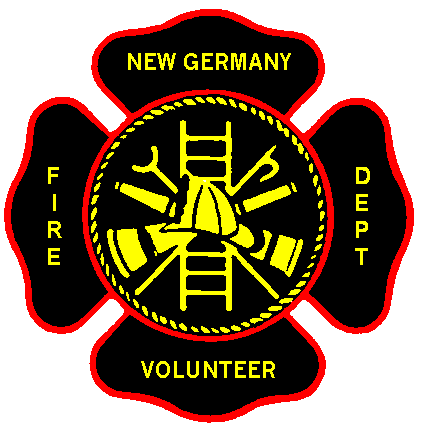A Brief History
(Click highlighted text for photos)In April of 1945, a 12 member brigade, headed by local mechanic Clarence Mosher, was organized and set about fundraising for the purchase of equipment. A committee, chaired by Roger Varner, canvassed residents and the goal of $600 was quickly realized.
Like so many communities, our first piece of apparatus was purchased through the War Assets Corporation. An Air Raid Precautions (ARP) pump trailer and 1500 feet of hose was protecting the village by June. These little pumps were highly serviceable and our rig would prove itself an aggressive fire-fighter well into the 1960's. Housed initially at the Chief's filling station, the old air raid siren would summon the members and the pump would be towed with the Chief's truck.
Following the end of World War II, returning servicemen provided a wealth of trained and experienced fire-fighters. By 1947, with large amounts of war materiel being declared surplus the Department was able to purchase a Dodge pumper for $612.50. A permanent home was needed and so a 2 bay hall was constructed in 1947 near the rail shed at a cost of $1600. Sadly, Chief Mosher passed away shortly after the hall was completed. With many renovations and expansions, this Hall continued in use until the opening of our present Hall in 2006.
Randal Mosher succeeded Chief Clarence and the expansion of the Department continued throughout his six year tenure. A serious mechanical breakdown would sideline the old ARP truck which was replaced with a pumper featuring a 500 gallon booster tank with front mount pump and a hose truck.
Ed Zwicker became Chief in 1952. Under his leadership, membership would continue to grow and the Department would purchase its first turnout gear. The affluence of the post-war years gave rise to many fire departments; leading to the formalization of most fire district boundaries. The communities of Northfield in the South, Hemford to the West and Springfield to the North would form their own brigades during the 1950's. Today, New Germany serves one of the largest rural districts in the Municipality.
By 1960, local physician J. Bruce Crowe assumed the white helmet and over the next 28 years the Department would embark on an ambitious plan of modernization and innovation that continues to make New Germany one of the leaders in the County's fire service. A major expansion of the Hall was completed, adding a caretaker's apartment and a larger apparatus floor. This allowed for the replacement, in the mid-1960's of both of the ageing rigs with two modern 625 gpm Thibault pumpers.
Dr. Crowe's energy and concern for the community would soon turn he and his men into pioneers in the fledgling field of EMS. Being more that 30 minutes from the nearest hospital, Dr. Crowe and his colleagues often treated emergency cases right in their offices, so the local ambulance service was a vital link. When Langille's Funeral Home was sold, the ambulance service was in jeopardy, so in 1973, the Department agreed to assume that duty. We operated a single ambulance unit out of the Hall until 1980 when new management agreed to re-establish the funeral home-based service. Today, EHS operates from a modern base in New Germany and enjoys a close working relationship with the Fire Department Rescue Company. Formed following an anonymous donation, Rescue Company #5 now operates up-to-date Holmatro Rescue tools as well as water and ice rescue equipment.
The Department continued to grow throughout the 1970's and 1980's with the arrival of VHF radio and the addition of a converted 1969 International oil tanker. Further hall renovations preceded the arrival in 1986 of an 840 gpm Thibault Attack Pumper. We outgrew the 1 ton rescue van so the 3 ton chassis from old Utility Truck #5 was converted into a medium duty rescue vehicle by BMI Industries of Oakhill. Members concentrated on training to be able to handle most any emergency.
Deputy Chief Everette Barry would assume command following the 1980 illness and passing of Chief Crowe. Dr Crowe's funeral was attended by members of many area departments, many of whom attribute New Germany's success to his legacy of foresight. Chief Barry's keen business sense and leadership skills served the Department well during the 1980's, a decade which saw further modernization and expansion of our equipment.
Perhaps the most spectacular blaze in department history erupted early on the morning of Dec 3, 1985, in a three-storey chicken barn on the Delong Poultry Farm near Barss Corner. Several thousand chicks died in the near tragic blaze; two fire-fighters narrowly escaped with their lives after being trapped in the structure. In the aftermath of that conflagration a number of operational reforms and a serious commitment to advanced training were made.
Elected in 1991, our current Chief Blair Lantz has served for 41 years and stresses regular training and upgrading for all members as well as the need for pre-planning. Strong fire prevention initiatives have made our entire community safer over the years. Many members have achieved the NFPA Level 1 training standard and many more have achieved certification in such advanced areas as Fireground Management, Rapid Intervention and Thermal Imaging Camera operation.
In 1991, the ageing tanker was replaced with a tanker/pumper built by Fort Garry, followed by a new GMC pumper built by Metalfab in 1994 featuring our first fully-enclosed crew cab. The 1969 Thibault pumper was retired and sold while the 1967 Thibault, Engine #3 was retired from active service in 2011 and remains with the Department as an emergency backup.
 <
<